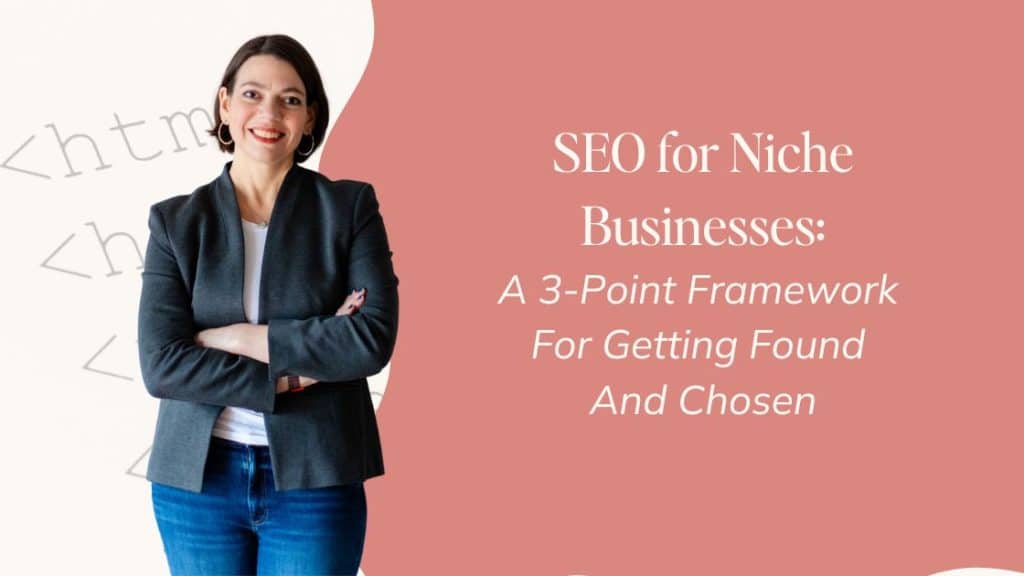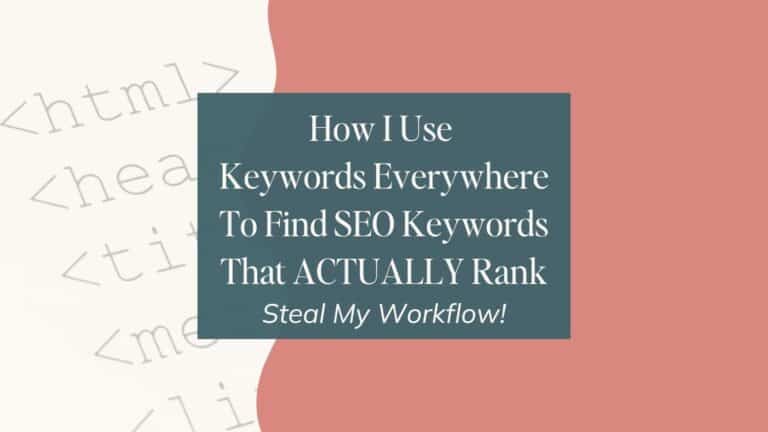
DRAW MORE RIGHT-FIT CLIENTS TO YOUR WEBSITE.
Subscribe to get your FREE Copy of the SEO SIMPLIFIED keyword research workbook.
Jump To:
You’ve probably heard that search engine optimization (SEO) is about driving more traffic.
But if you run a niche business, traffic alone won’t fill your calendar or pay your bills.
You don’t need traffic for traffic’s sake. You need to be discoverable by the right people at exactly the right time.
What is a niche business?
A niche business serves a very specific slice of a larger market. It’s built around specialized expertise, distinct values, or a unique audience.
Whether you work with creatives, wellness professionals, or small B2B clients, your audience is intentionally small, and that’s a strength.
Your success depends on connecting with the handful of people who are already searching for what you do, not the many who aren’t a fit.
What makes SEO for niche markets different?
SEO for niche markets is about precision.
Instead of broad, competitive keywords, you focus on long-tail, intent-driven searches that reflect how your ideal clients describe their problems or goals. The traffic numbers might look modest, but the intent behind those searches is strong and that’s what drives conversions.
The good news? You don’t need a massive content calendar or a big team to compete.
You need a focused, sustainable strategy built on three pillars:
- Discoverability → showing up in valuable, relevant searches.
- Visibility → staying present in places your ideal customers are paying attention, before they ever type your name into Google.
- Credibility → proving you’re actually a trustworthy expert once they find you.
When these three pillars work together, your website becomes a genuine extension of your business, helping you get found, build trust, and bring in clients who are the right fit for what you do.
Discoverability: Show Up in the Searches That Matter
Discoverability means being findable in Google when someone goes looking for help. In a niche business, this is where your SEO work starts.
Why it matters
Your audience is smaller, and many people don’t even know your service exists yet. That means they may not be searching for your job title. Instead, they may be searching for the problem they can name in their own words.
Discoverability helps your website shows up in those moments of need, connecting your expertise to their questions.
How it works
Someone searching for relief from jaw pain might type, “How do I get rid of chronic jaw tension?” before realizing a myofascial release therapist could help.
A coaching prospect might Google, “How to stop worrying about money” long before they discover the term money mindset coach.
And a law firm owner might look up, “How do I market my law firm?” without knowing that there are copywriters who specialize in Google Ads for attorneys.
But here’s the nuance: service-specific keywords still matter. Some people do know what they want, and when they search, they’re laser-focused:
- “Copywriter for therapists”
- “Website designer for health and wellness brands”
- “Online postpartum personal training”
Both types of searches matter.
The problem-driven queries help new people discover you early. The solution-driven queries make sure you’re visible when someone is ready to hire.
What to prioritize
There are two main types of searches you want to appear for:
- Problem-driven searches. Early-stage queries that help new people find you and start to build awareness.
- Solution-driven searches. High-intent phrases that make sure you’re visible when someone is ready to hire.
Your strategy should connect the two. Use blog posts and resources as a wide net to capture the questions, and service pages to clearly state what you do and how to take the next step.
KEYWORD TIP: How to find your “problem-driven” keywords
Those problem-based queries, the how, why, and what questions your clients type into Google, are examples of top-of-funnel (TOFU) searches. These capture people at the very beginning of their journey, when they’re still trying to understand or name their problem, before they even know you or your solution exists.
For niche businesses, TOFU keywords are gold because they help you share solutions and educate potential clients who wouldn’t find you through a direct search.
TOFU searches often use long-tail keywords: longer, more specific phrases that reflect how people naturally search. They can even be full questions.
Long-tail keywords tend to have lower search volume but stronger search intent, meaning the searcher is closer to taking action, which makes them especially valuable in small, specialized markets.
Where to find them: Start with your inbox, sales calls, and client questions. Check Google Search Console for the phrases already bringing visitors to your site. Tools like Google’s autocomplete, “People also ask,” or AnswerThePublic can reveal more ideas.
Where to use them: TOFU keywords work best in blog posts, FAQs, and resource pages, anywhere you can answer common questions and build trust early. Link those pages to your core services to guide readers deeper into your site.
For a deeper walkthrough of how to uncover these keywords, read 5 Seriously Smart Ways to Figure Out What Your Audience is Searching For
Visibility: Get Seen Where People Aren't Searching (Yet)
The second pillar of niche market SEO is visibility—expanding your online presence beyond your website to reach people who might not yet know you or realize they need your services.
By showing up in the spaces where your ideal clients already spend time, you create recognition that pays off later, when they’re ready to search for what you offer.
Why it matters
Visibility plants the seed: “I’ve seen her before.” That familiarity turns into branded searches and even direct referrals because now you’re on your audience’s radar.
Where to show up
Focus on a few trusted platforms that both your audience and Google value:
- LinkedIn for thought leadership and professional conversations.
- YouTube for short, practical videos (which also rank well in Google).
- Podcasts for deeper storytelling and credibility.
- Industry directories or publications where people look for recommendations (stick to industry-trusted or high-authority ones. Generic directories have little SEO value now.).
Bottom line: Visibility means showing up before someone knows to search for you. By consistently sharing your perspective in trusted spaces, you build familiarity today that leads to branded searches, backlinks, and direct inquiries tomorrow.
The Recognition → Search Pipeline
Most specialized service providers think SEO starts and ends with their website. But the real opportunity lies in creating a pipeline where visibility leads to recognition, which eventually leads to branded searches.
Here’s how it works: Someone sees your LinkedIn article about decision fatigue in entrepreneurs. They don’t need help right now, but your name sticks. Three months later, when they’re struggling with exactly that issue, they think, “What was that person’s name who wrote about this?” and they search for you specifically.
This is the compound effect of strategic visibility. You’re not just trying to capture existing demand. You’re creating future demand by positioning yourself as the expert in conversations that matter to your ideal clients.
Credibility: Become the Obvious Choice
Once people find you, they want to know they can trust you. Credibility signals to both your audience and Google that you’re reliable, knowledgeable, and worth paying attention to.
Why it matters
When someone lands on your site, they’re looking for the proof that says, “this person knows what they’re doing.” Reviews, testimonials, case studies, and media features act as that proof. They show real experience and reinforce trust.
This is especially important when your audience hasn’t heard of your service before. If what you do is unfamiliar, skepticism is natural. Credibility bridges that gap. It gives people a reason to believe that your work delivers results, even if they’ve never searched for someone like you before.
For Google, these same signals, plus consistent information across your online profiles, help confirm that your business is authentic and established.
What to prioritize
Credibility comes from a mix of ‘on-page” and “off-page” signals:
- Content that teaches and clarifies. Blog posts, guides, and resources that answer the questions your ideal clients actually ask.
- Thought leadership. Guest interviews, podcasts, or features that expand your reach and credibility.
- Social proof. Testimonials, reviews, and case studies that show results in context.
- Backlinks from high-trust sources that signal legitimacy to Google.
How to build it
Build credibility by consistently sharing what you know, showing the results you deliver, and connecting those pieces across your online presence.
Publish high-quality, educational content that demonstrates your expertise and speaks to your audience’s needs. Keep your testimonials, case studies, and reviews visible and up to date. And make sure Google can see those connections with schema markup and strong internal links between related content.
When you combine these elements, you’re telling people you’re an expert and you’re proving it in a way that both your audience and Google can verify.
Setting expectations and measuring impact
SEO for niche markets is about alignment: being discoverable when it matters, visible where your ideal clients spend time, and credible enough to be the obvious choice. These three pillars work together to create a system for sustainable lead generation.
Timeline expectations
Building SEO momentum takes time, especially in a specialized market. You’re creating signals of expertise and relevance that compound as you publish, update, and earn trust.
Think of SEO as a long game. Consistent effort over several months builds authority, while one-time efforts won’t get noticed.
Small, steady improvements to your website and content add up to stronger search rankings and more qualified leads.
Measuring impact
When your audience is small and specific, success isn’t reflected in sheer traffic volume. What matters is whether your SEO efforts are increasing your visibility in meaningful ways.
Are your pages starting to rank for the keywords you’ve intentionally targeted?
Are your impressions and clicks growing for the topics most relevant to your services?
These are the early signs that Google understands what you’re an expert in and is matching you and your business to relevant searches.
From there, the true measure of success is what happens off the screen:
- Consultation bookings. More people reaching out for discovery calls or consultations.
- Lead quality. Inquiries that align with your services, budget, and scope.
- Client alignment. Projects and partnerships that fit your expertise, values, and preferred way of working.
When you see these outcomes improving, it means your SEO is doing its job. It’s helping the right people find you, trust you, and take the next step toward working with you.
Struggling to figure out what your clients are actually typing into Google?
That’s one of the biggest challenges for niche businesses and it’s exactly what my free resource, SEO Simplified, is designed to solve.
It walks you through a simple, repeatable process to brainstorm, validate, and organize the long-tail, problem-driven keywords your clients use when they’re looking for help.
That list becomes the raw material for content that connects you with the right clients.
If you’re ready to make your site findable by the right people, SEO Simplified is the next step.








